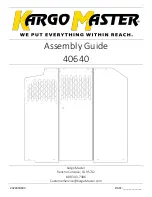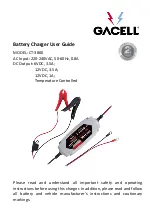
automatically causes the trailer air supply valve to
pop out.
NOTICE
Do not use the spring parking brakes if the ser-
vice brakes are hot, such as after descending a
steep grade. To do so could damage the brakes.
Allow hot brakes to cool before using the spring
parking brakes.
Do not use the spring parking brakes during
freezing temperatures if the service brakes are
wet. To do so could cause them to freeze. If the
brakes are wet, drive the vehicle in low gear and
lightly apply the brakes to heat and dry them.
If the trailer is not equipped with spring parking
brakes, pulling out the parking brake valve applies
the tractor spring parking brakes and the trailer ser-
vice brakes. When the tractor and trailer parking
brakes (or trailer service brakes) are both applied,
the trailer brakes are released by pushing in the
trailer air supply valve, leaving the tractor parking
brakes applied. Air pressure in the primary or sec-
ondary reservoir must be at least 65 psi (447 kPa)
before the tractor spring parking brakes, or the trailer
service or spring parking brakes, can be released.
Automatic Slack Adjusters
Automatic slack adjusters should never be manually
adjusted except during routine maintenance of the
foundation brakes (e.g., replacing shoes), during
slack adjuster installation, or in an emergency situa-
tion.
When the brake pushrod stroke exceeds the legal
brake adjustment limit on a vehicle, there is likely a
mechanical problem with the foundation brake com-
ponents or the adjuster is improperly installed.
Visit a repair facility as soon as possible when
brakes equipped with automatic slack adjusters are
determined to be out of adjustment.
NOTICE
Manually adjusting an automatic slack adjuster to
bring the pushrod stroke within legal limits is not
repairing. In fact, continual adjustment of auto-
matic slack adjusters may result in premature
wear of the adjuster itself. Further, the improper
adjustment of some automatic slack adjusters
may cause internal damage to the adjuster,
thereby preventing it from properly functioning.
Meritor WABCO® Antilock
Braking System
The Meritor WABCO Antilock Braking System (ABS)
is an electronic wheel speed monitoring and control
system that works with the standard air brake sys-
tem. ABS passively monitors vehicle wheel speed at
all times, and controls wheel speed during emer-
gency stops or wheel lock situations.
IMPORTANT: For proper ABS system operation,
do not change tire sizes. The sizes of the tires
installed during production are programmed into
the electronic control unit. Installing different-
sized tires could result in a reduced braking
force, leading to longer stopping distances.
ABS includes signal-generating tone wheels and sen-
sors located in the wheel hubs of each sensed
wheel. The sensors transmit vehicle wheel speed
information to an electronic control unit (located be-
hind the center dash). The control unit’s main circuit
interprets the speed sensor signals and calculates
wheel speed, wheel retardation, and a vehicle refer-
ence speed. If the calculations indicate wheel lockup,
the main circuit signals the appropriate modulator
valve to reduce braking pressure. During emergency
braking, the modulator valve alternately reduces, in-
creases, or maintains air pressure supply in the
brake chamber to prevent front and rear wheel
lockup.
The electronic control unit also has a safety circuit
that constantly monitors the wheel sensors, traction
control valve (if equipped), modulator valves, and the
electrical circuitry.
The Meritor WABCO ABS combines one front-axle
control channel with one rear-axle control channel to
form one control circuit. For example, the sensor and
modulator valve on the left-front axle form a control
circuit with the sensor and modulator valve on the
right-rear axle. If, during vehicle operation, the safety
circuit senses a failure in any part of the ABS, the
tractor warning lamp (TRACTOR ABS) illuminates
and the control circuit where the failure occurred is
switched to normal braking action. The remaining
control circuit will retain the ABS effect. Even if the
ABS is completely inoperative, normal braking ability
is maintained. An exception would be if a modulator
Brake Systems
12.3
Содержание 108SD
Страница 1: ...Driver s Manual 108SD and 114SD Part Number STI 496 Publication Number STI 496 6...
Страница 16: ...3 Electrical System Vehicle Power Distribution 3 1 Load Disconnect Switch 3 1 Battery Access 3 2...
Страница 60: ...7 Climate Control Climate Control Panel 7 1...
Страница 65: ...8 Cab Features Cab Amenities 8 1 Mirrors and Windows 8 1...
Страница 68: ...10 05 2001 f670096 1 2 1 Latch 2 Vent Window Fig 8 7 Operating Vent Window optional Cab Features 8 3...
Страница 69: ...9 Engine Starting Operation and Shutdown Engine Starting 9 1 Engine Operation 9 2 Engine Shutdown 9 3...
Страница 121: ...15 Drive Axles Differential Lock Drive Axles 15 1 Interaxle Lock Tandem and Tridem Axles 15 2...
Страница 125: ...16 Steering System Power Steering System 16 1...
Страница 138: ...18 Trailer Couplings Air Suspension Dump Valve 18 1 Holland Trailer Coupling 18 1 Premier Trailer Couplings 18 2...
Страница 153: ...20 Pre and Post Trip Checklists Periodic Inspections and Maintenance 20 1 Checklists 20 1 Fluids Added 20 2...
Страница 176: ...23 Headlight Aiming Preliminary Checks 23 1 Checking Headlight Aim 23 1 Adjusting Headlight Aim 23 2...
Страница 179: ...05 13 2009 f545526 Fig 23 3 Headlight Adjusting Headlight Aiming 23 3...
















































